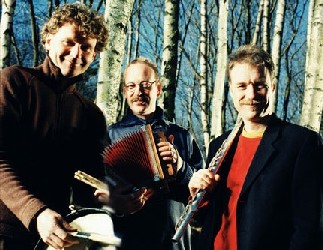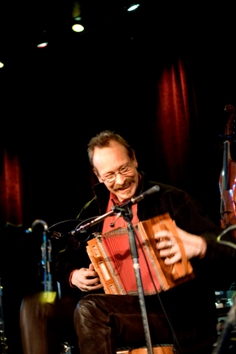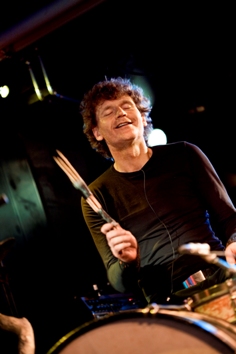
FolkWorld Issue 39 07/2009; Article by Eelco Schilder
Mats Edén & Groupa
Part 2: The Groupa Years
In the first part of the interview with Mats Edén, which was published in the previous issue of Folkworld, he talked about the years before Groupa was founded. He ended by explaining the ideas behind the band and introducing the first line up. In this second, and last, part of the interview he gives a brief history of the band.
 |
The start was fine, with both the first and the second line up. Some more conservative people in the folk scene did not appreciate what we were up to, but we could not care less. In those days people were not accustomed to anything but the traditional way of playing folk music and were not familiar with other styles. We attracted a great deal of attention, although we had not completely developed a style of our own then. We were still trying out many different ideas and some worked out better than others. When we started with the new line up, we decided to try and mix our own compositions with some old traditional tunes. Everybody came up with new tunes, although we later made most use of the ones I had contributed. We also had some new ideas about presenting our music, for instance Irish tunes, which were played in longer sets.
On Vildhonung this idea did not really come through, but we had also experimented with improvisations and such and the reactions to the album were positive. I think our music had already developed a lot as compared to the start in 1983. If I had to describe our style in those first years, I would say it was a blend of Norwegian and western Swedish traditional music, mixed with and influenced by all the music we liked and could play. Our third album contained the same kind of music as the second one, but even more developed. We wanted to find a good mixture of arrangements, improvisations and each member’s personal preferences. We had lengthy table discussions and talked about what we took to be important ingredients for our music.
 In the same period another Swedish band, called Filarfolket, was founded. This band is often compared with Groupa, although the ways of interpreting traditional music are quite different.
How was the relationship between these two bands?
In the same period another Swedish band, called Filarfolket, was founded. This band is often compared with Groupa, although the ways of interpreting traditional music are quite different.
How was the relationship between these two bands?
Both bands are connected in many ways. Ale Moller, one of the Filarfolket members, produced two of our records, Vildhonung (1985) and Utan Sans (1988), the latter being nominated for the Swedish Grammy. We were similar in that we both had strong musical identities, great admiration and respect for the tradition and the will to interpret folk music in a modern way for contemporary audiences. Together with Filarfolket, Groupa organized some big events and concerts. The great finale was a huge project in 1990, which cost us almost a year to organize. Both bands performed in a circus tent and toured all around the country for a month during the summer of that year. So, as you will understand, we worked together very closely indeed.
On the next few albums Groupa cooperates with a few well-known female Swedish singers. How did they get involved with the band and what can you tell us about the albums you recorded with them?
Groupa first worked with Inger Stinnerbom and later with Lena Willemark. Working with Lena started as a project in 1987, or maybe 1985, I don't remember exactly. We were asked to do a luncheon concert, the kind of thing the radio still broadcast in those days. Lena was there as well and we played one or two tunes together. After the concert we asked Lena whether she was interested in working together for a longer period of time and she stayed with us until 1991 or 1992. After we had recorded Månskratt, Lena left the project and so did Totte, who started Hedningarna. Then Tina Johansson became our lead singer and with her we recorded Imeland, for which we were awarded a Grammy. This album gave us more freedom in musical terms, but it was still a combination of new songs and traditional tunes, like the ones that I had learnt from Ånon Egeland. The group was reduced to no more than four members then and, in a way, it was easier to make music with fewer musicians.
 Tina, who was our percussionist as well, left after recording the album mentioned before and a few new group members came and went. For Lavalek we asked Sofia Karlsson to join us as the lead singer. Slowly we added more jazz influences and modern styles to our music and this can best be heard on Fjalar, which in a way was a continuation of Lavalek. We used some music that we had experimented with during sessions, like the hymn with the mouth harp as the basic sound. Sofia only sings a few fragments of this hymn and the music was intended to be a kind of soundscape. Then there is the title song, in which Rickard is improvising a bit more in the jazz vein. I like the character and the sort of ‘deformed’ sound of this record. It is an album that, towards the end, slowly loses it’s dark touch and ending in bright daylight. So, in a way, it is a balance between soundscapes and more basic material.
Tina, who was our percussionist as well, left after recording the album mentioned before and a few new group members came and went. For Lavalek we asked Sofia Karlsson to join us as the lead singer. Slowly we added more jazz influences and modern styles to our music and this can best be heard on Fjalar, which in a way was a continuation of Lavalek. We used some music that we had experimented with during sessions, like the hymn with the mouth harp as the basic sound. Sofia only sings a few fragments of this hymn and the music was intended to be a kind of soundscape. Then there is the title song, in which Rickard is improvising a bit more in the jazz vein. I like the character and the sort of ‘deformed’ sound of this record. It is an album that, towards the end, slowly loses it’s dark touch and ending in bright daylight. So, in a way, it is a balance between soundscapes and more basic material.
While recording ‘Frost’, Groupa’s latest album, the band consisted of a trio again. Was this a conscious choice or just circumstantial?
When Rikard left the band, we decided not to bring in another musician. We felt that it would be like starting all over again. We kept on playing the same repertoire, but we had to make do without a keyboard. We had to get used to missing the sound of a keyboard, but it also provided new possibilities. When we started working on the new album, the idea hit us that we wanted a purer, more “naked” sound. We did not feel the need for another Lavalek or Fjalar. We recorded every tune in one set, while sitting very close to one another. We did not bother recording, for instance, the flute in a separate room to prevent its sound leaking to the percussion channel. At the end we only added small details, like my drones on the accordion. We wanted the record to be like a conversation between the musicians and their instruments.
Any idea what the future will bring?
Not really, we simply want to do more concerts and play our music. The thing is: it takes us a long time to bring together new material as we live far apart, so we tend to work in periods. I know that Terje and Jonas are working on some new tunes and I have a lot of tunes that we have not used yet. Last year we participated in an interesting project with two rock musicians and we might do something like that again. They wrote the music and lyrics and then we performed together. The project comprised 4 concerts and a recording was made, but I do not know what will happen with it. It may be released next year.
 Besides being a member of Groupa, you are also involved in many other musical projects. Can you give a short introduction to your other work?
Besides being a member of Groupa, you are also involved in many other musical projects. Can you give a short introduction to your other work?
Together with Jonas I play in a group called Crane dance trio. The music is released on Jonas’ solo album Crane Dance [FW#36]. I also form a duo with percussionist Tina Quartey, with whom I have recorded one album called Vägen In on the Amigo label. We are not performing at the moment, but we do have plans to take it up again. Another project concerns playing the traditional tunes from a local musician in Värmland - Oskar Andersson from Mangskog. For this project I work together with accordionist Sven Ljungberg and guitarist Totte Mattsson. We call the trio Gubbatrio and made one album in 1986. It is no longer for sale, which is a pity because I think it is one of the best I have ever made. These are only a few of my recent plans and projects. I have also come into contact with the contemporary music scene in Malmö and know some musicians there. One of our plans is to go on a tour with the guitar-player Stefan Östersjö and the accordionist Geir Draugsvold. Furthermore, I have discussed playing together with the cello-player Mattias Rodric, who plays both the cello and the electric cello. And I have also been talking with some other musicians, like Stefan Klaverdal, who "plays" the computer, but I do not know what this come of this. Stefan and I have had plans to work together as a duo for a number of years now, but we would also like to have a commission for a bigger work. A concerto for guitar, folk fiddle and orchestra, for instance.
Besides making music, I write a lot of classical music and one project will be recorded and hopefully released in 2010. We started with two pieces: my first violin concerto with soloist Anne Sophie Andersen and the concerto for soprano saxophone with Johnny Hedlund as a soloist. In February a composition I made for the Swedish radio was broadcast in sixteen countries. Göran Månsson, a flutist in the ensemble, is working hard to get a commission for me, so that I can compose a concerto for recorders. In addition to this, I work part time at the Academy of Music in Malmö as a teacher of folk music, ensemble, violin and folk music solfége. I sometimes teach at other academies as well, but not on a regular basis. In the past I was a guest teacher at the Sibelius Academy, Det Fynske Musikkonservatorium in Odense, Örebro Musikhögskola and the University in Ljubjana and several other academies.
| Groupa Discography: Av bara farten (1983, Amigo AMCD729), Vildhonung (1985, Amigo AMCD729), Utan sans (1989, Amigo AMCD721), Månskratt (1990, Amigo AMCD725), Imeland (1995, Amigo AMCD730), Lavalek (1998, Xsource XOUCD125), Fjalar (2002, Xsource XOUCD134), Frost (2008, Footprint FRCD040) |
Photo Credits:
(1) Groupa (from website);
(2) Mats Edén, (3) Jonas Simonson, (4) Terje Isungset (by Kristin Lidell).
|
To the German FolkWorld |
© The Mollis - Editors of FolkWorld; Published 07/2009
All material published in FolkWorld is © The Author via FolkWorld. Storage for private use is allowed and welcome. Reviews and extracts of up to 200 words may be freely quoted and reproduced, if source and author are acknowledged. For any other reproduction please ask the Editors for permission. Although any external links from FolkWorld are chosen with greatest care, FolkWorld and its editors do not take any responsibility for the content of the linked external websites.
